语言学教学步骤
- 格式:doc
- 大小:123.00 KB
- 文档页数:20



2024精选语言学概论教案目录•语言学基本概念与理论•语音、音系与音变规律•词汇、语义与语用研究•句法、篇章与修辞技巧•语言与社会文化关系探讨•语言发展变化与保护传承PART01语言学基本概念与理论语言定义及功能语言定义语言是人类用于交际和表达思想的符号系统,具有任意性、线条性、社会性等特点。
语言功能语言具有交际功能、认知功能、文化功能等多重功能,是人类社会不可或缺的重要组成部分。
语言学研究对象与方法语言学研究对象语言学以语言为研究对象,包括语言的性质、结构、发展演变以及语言与思维、文化、社会等方面的关系。
语言学研究方法语言学研究方法包括描写法、历史比较法、实验法、统计法等,旨在揭示语言的本质和规律。
结构主义语言学功能主义语言学转换生成语法认知语言学语言学流派及其理论以索绪尔为代表的结构主义语言学强调语言的共时性研究,关注语言符号之间的关系和系统性。
以乔姆斯基为代表的转换生成语法关注语言的生成能力和内在结构,提出普遍语法的概念。
以韩礼德为代表的功能主义语言学注重语言的功能研究,强调语言在社会交际中的作用。
认知语言学认为语言是人类认知的一部分,关注语言与认知、文化等方面的关系。
PART02语音、音系与音变规律语音基本概念及分类语音定义语音是人类通过发音器官发出的具有区别意义功能的声音,是语言的物质外壳。
语音分类根据发音部位和发音方法的不同,语音可分为元音和辅音;根据音高、音强和音长的不同,语音可分为乐音和噪音。
音系结构与特点音系定义音系是指一种语言中所有语音成分的系统,包括单音、音节、重音、语调等。
音系结构音系结构包括音段音系和超音段音系。
音段音系研究元音、辅音等语音单位,超音段音系研究重音、语调等语音特征。
音系特点不同语言的音系具有不同的特点,如元音的数量、辅音的发音部位和发音方法等。
同时,同一语言内部不同方言的音系也存在差异。
音变规律及实例分析音变定义01音变是指语音在历时或共时层面上的变化现象,包括语音的简化、繁化、异化等。
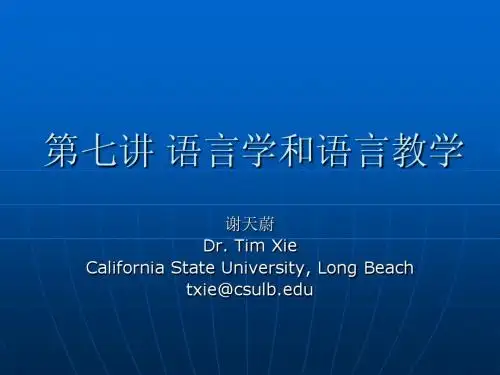
第七讲语言学和语言教学谢天蔚Dr. Tim XieCalifornia State University, Long Beachtxie@一、语言学理论和语言教学法⏹语言教学法总是和语言学理论相适应⏹语法研究和语法翻译法⏹结构主义和视听法、句型操练⏹社会语言学与交际法、交际能力语法翻译法grammar translation 语法翻译法是中世纪欧洲人教希腊语、拉丁语等死语言的教学法,到了十八世纪,欧洲的学校虽然开设了现代外语课,但仍然沿用语法翻译法,学习外语的目的,主要是为了阅读外语资料和文献。
语法翻译法是为培养阅读能力服务的教学法。
其教学过程是先分析语法,然后把外语译成本族语。
主张两种语言机械对比和逐词逐句直译。
在教学实践中把翻译当成教学目的,又当成教学手段。
语法翻译法重视阅读、翻译能力的培养和语法知识的传授,忽视语言技能的培养,语音、词汇、语法与课文阅读教直接法Direct method⏹十九世纪下半叶始于西欧的外语教学⏹德国外语教育家菲埃托最早提出⏹十九世纪语音学的建立和发展为直接法提供了语音教学的科学基础⏹直接法主张采用口语材料作为教学内容⏹强调模仿,主张用教儿童学习本族语言的方法,⏹“通过说话学说话”的方法来学习外语⏹教学中只用外语讲述,广泛利用手势、动作、表情、实物、图画等直观手段,要求外语与思想直接联系,绝对不使用本族语,⏹即完全不借助于翻译,语法降到完全不重要的地位。
⏹完全针对语法翻译法的弊端提出的,本身难免有它的局限性和片面性的地方,对母语在外语教学中的作用,只看到消极的一面,而没有看到或充分估计到它的积极的一面;⏹只看到和只强调幼儿学母语和已掌握了母语的人学习外语之间的共同规律,而对两者之间的差别未曾注意到或没有充分估计到,因此采用了基本相同的方法来解决两种有一定区别的语言学习问题;⏹在教学中偏重经验、感性认识,而对人的自觉性估计不足,对文学的修养不够注意,对许多语言现象只知其然而不知其所以然。
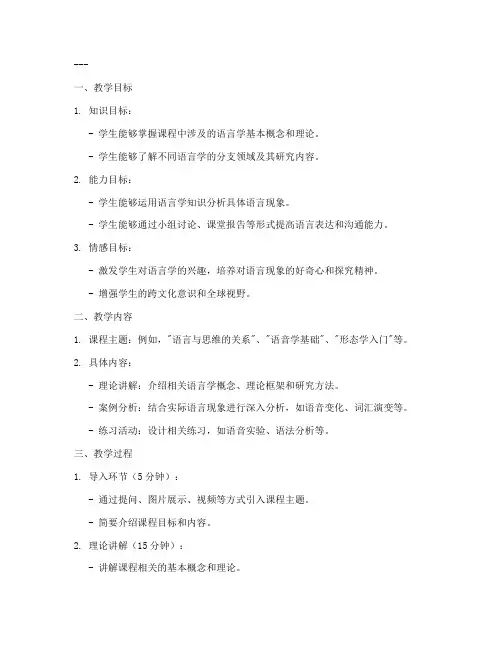
---一、教学目标1. 知识目标:- 学生能够掌握课程中涉及的语言学基本概念和理论。
- 学生能够了解不同语言学的分支领域及其研究内容。
2. 能力目标:- 学生能够运用语言学知识分析具体语言现象。
- 学生能够通过小组讨论、课堂报告等形式提高语言表达和沟通能力。
3. 情感目标:- 激发学生对语言学的兴趣,培养对语言现象的好奇心和探究精神。
- 增强学生的跨文化意识和全球视野。
二、教学内容1. 课程主题:例如,"语言与思维的关系"、"语音学基础"、"形态学入门"等。
2. 具体内容:- 理论讲解:介绍相关语言学概念、理论框架和研究方法。
- 案例分析:结合实际语言现象进行深入分析,如语音变化、词汇演变等。
- 练习活动:设计相关练习,如语音实验、语法分析等。
三、教学过程1. 导入环节(5分钟):- 通过提问、图片展示、视频等方式引入课程主题。
- 简要介绍课程目标和内容。
2. 理论讲解(15分钟):- 讲解课程相关的基本概念和理论。
- 结合实例,帮助学生理解抽象概念。
3. 案例分析(20分钟):- 分享具体语言现象的案例分析。
- 引导学生思考并讨论,培养学生的分析能力。
4. 练习活动(15分钟):- 设计练习,如语音实验、语法分析等,让学生将理论知识应用于实际。
- 鼓励学生自主学习和探索。
5. 小组讨论(15分钟):- 将学生分成小组,针对特定问题进行讨论。
- 鼓励学生分享观点,提高团队合作能力。
6. 课堂报告(10分钟):- 学生代表小组进行课堂报告,展示讨论成果。
- 教师点评,总结讨论要点。
7. 总结与反思(5分钟):- 总结课程内容,强调重点和难点。
- 引导学生反思学习过程,提出改进建议。
四、教学资源1. 教材:选用合适的语言学教材或参考书。
2. 多媒体资源:如图片、视频、音频等,丰富教学内容。
3. 网络资源:推荐相关网站、论坛等,拓展学习渠道。
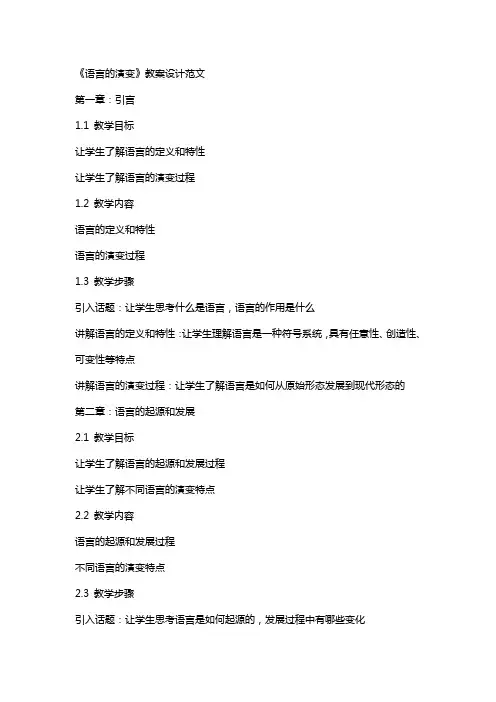
《语言的演变》教案设计范文第一章:引言1.1 教学目标让学生了解语言的定义和特性让学生了解语言的演变过程1.2 教学内容语言的定义和特性语言的演变过程1.3 教学步骤引入话题:让学生思考什么是语言,语言的作用是什么讲解语言的定义和特性:让学生理解语言是一种符号系统,具有任意性、创造性、可变性等特点讲解语言的演变过程:让学生了解语言是如何从原始形态发展到现代形态的第二章:语言的起源和发展2.1 教学目标让学生了解语言的起源和发展过程让学生了解不同语言的演变特点2.2 教学内容语言的起源和发展过程不同语言的演变特点2.3 教学步骤引入话题:让学生思考语言是如何起源的,发展过程中有哪些变化讲解语言的起源和发展过程:让学生了解语言起源于人类的社交需求,经历了从口语到书面语的演变过程讲解不同语言的演变特点:让学生了解不同语言在语音、语法、词汇等方面的演变特点第三章:语言的演变因素3.1 教学目标让学生了解影响语言演变的因素让学生了解语言演变的速度和规律3.2 教学内容影响语言演变的因素语言演变的速度和规律3.3 教学步骤引入话题:让学生思考是什么因素影响了语言的演变讲解影响语言演变的因素:让学生了解社会、文化和接触等因素对语言演变的影响讲解语言演变的速度和规律:让学生了解语言演变的速度和规律,以及不期的演变特点第四章:语言的演变现象4.1 教学目标让学生了解语言演变中出现的一些现象让学生了解这些现象背后的原因和机制4.2 教学内容语言演变中出现的一些现象这些现象背后的原因和机制4.3 教学步骤引入话题:让学生思考在语言演变中出现了哪些有趣的现象讲解语言演变中的现象:让学生了解语音变化、语法变化、词汇变化等现象讲解这些现象背后的原因和机制:让学生了解社会、文化和接触等因素对语言演变的影响第五章:语言的演变与语言学5.1 教学目标让学生了解语言演变与语言学的关系让学生了解语言学家如何研究语言演变5.2 教学内容语言演变与语言学的关系语言学家如何研究语言演变5.3 教学步骤引入话题:让学生思考语言演变与语言学之间的联系讲解语言演变与语言学的关系:让学生了解语言演变是语言学研究的对象之一讲解语言学家如何研究语言演变:让学生了解语言学家通过比较、分析和归纳等方法研究语言演变第六章:语言接触与借贷6.1 教学目标让学生了解语言接触的概念让学生了解语言借贷的现象及其对语言演变的影响6.2 教学内容语言接触的概念语言借贷的现象及其对语言演变的影响6.3 教学步骤引入话题:通过具体实例让学生思考不同语言之间的接触现象讲解语言接触的概念:让学生了解语言接触是指不同语言使用者的语言相互影响的过程讲解语言借贷的现象及其对语言演变的影响:让学生了解语言借贷是指一种语言从另一种语言借用的词汇、语法结构等,以及这种现象如何影响语言的演变第七章:社会文化与语言演变7.1 教学目标让学生了解社会文化与语言演变的关系让学生了解社会文化因素如何影响语言的演变7.2 教学内容社会文化与语言演变的关系社会文化因素如何影响语言的演变7.3 教学步骤引入话题:通过具体实例让学生思考社会文化与语言之间的关系讲解社会文化与语言演变的关系:让学生了解社会文化对语言演变的影响讲解社会文化因素如何影响语言的演变:让学生了解社会文化因素如教育、媒体等如何影响语言的演变第八章:语言政策与语言演变8.1 教学目标让学生了解语言政策的概念让学生了解语言政策如何影响语言的演变8.2 教学内容语言政策的概念语言政策如何影响语言的演变8.3 教学步骤引入话题:通过具体实例让学生思考政府如何通过政策来管理语言讲解语言政策的概念:让学生了解语言政策是指政府为管理语言而制定的规划和措施讲解语言政策如何影响语言的演变:让学生了解语言政策如何影响语言的使用和演变第九章:语言与思维的关系9.1 教学目标让学生了解语言与思维的关系让学生了解语言如何影响思维方式9.2 教学内容语言与思维的关系语言如何影响思维方式9.3 教学步骤引入话题:通过具体实例让学生思考语言与思维之间的关系讲解语言与思维的关系:让学生了解语言不仅是表达思维的工具,也能影响思维方式讲解语言如何影响思维方式:让学生了解不同语言的使用者可能有不同的思维特点和方式第十章:总结与展望10.1 教学目标让学生总言演变的要点和知识点让学生展望语言演变未来的发展趋势10.2 教学内容总言演变的要点和知识点展望语言演变未来的发展趋势10.3 教学步骤让学生回顾整个课程的内容,总言演变的要点和知识点让学生思考当前全球化和科技发展对语言演变的影响展望语言演变未来的发展趋势:让学生了解语言演变是一个持续进行的过程,未来可能会出现新的演变现象和趋势重点和难点解析本教案设计的重点在于让学生理解和掌握语言的定义和特性、语言的演变过程、影响语言演变的因素、语言演变的现象以及语言与思维的关系等核心知识点。
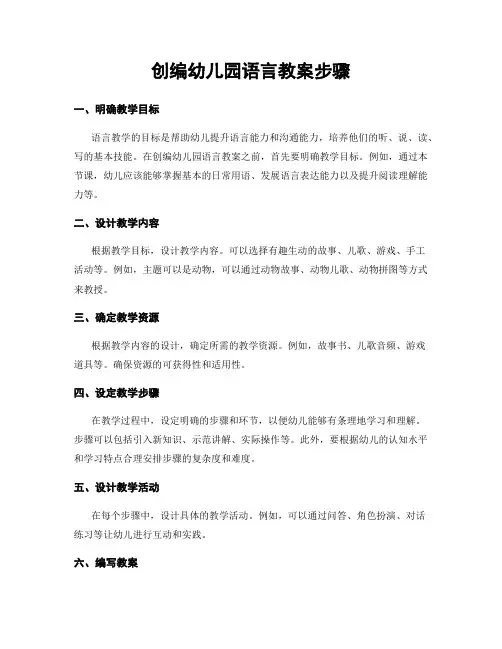
创编幼儿园语言教案步骤一、明确教学目标语言教学的目标是帮助幼儿提升语言能力和沟通能力,培养他们的听、说、读、写的基本技能。
在创编幼儿园语言教案之前,首先要明确教学目标。
例如,通过本节课,幼儿应该能够掌握基本的日常用语、发展语言表达能力以及提升阅读理解能力等。
二、设计教学内容根据教学目标,设计教学内容。
可以选择有趣生动的故事、儿歌、游戏、手工活动等。
例如,主题可以是动物,可以通过动物故事、动物儿歌、动物拼图等方式来教授。
三、确定教学资源根据教学内容的设计,确定所需的教学资源。
例如,故事书、儿歌音频、游戏道具等。
确保资源的可获得性和适用性。
四、设定教学步骤在教学过程中,设定明确的步骤和环节,以便幼儿能够有条理地学习和理解。
步骤可以包括引入新知识、示范讲解、实际操作等。
此外,要根据幼儿的认知水平和学习特点合理安排步骤的复杂度和难度。
五、设计教学活动在每个步骤中,设计具体的教学活动。
例如,可以通过问答、角色扮演、对话练习等让幼儿进行互动和实践。
六、编写教案根据设定的步骤和活动,编写教案。
教案应包含详细的教学内容、教学目标、教学资源、教学步骤以及评价方法等。
教案的编写要清晰明了,便于教师执行和幼儿理解。
七、教案试教教师在教案编写完成后,可以先进行试教,了解教案的可行性和有效性。
在试教过程中,可以根据幼儿的实际情况,对教案进行适当修改和调整。
八、教学实施根据编写好的教案,进行实际的教学实施。
教师要在课堂上运用教案中设计的活动和方法,引导幼儿积极参与学习。
同时,教师还要根据幼儿的情况进行灵活调整,确保教学效果。
九、巩固与拓展教学结束后,要对所学内容进行巩固与拓展。
可以通过复习、扩展作业、激发幼儿的思维等方式来巩固所学知识。
十、评价与总结对教学过程进行评价,了解幼儿的学习情况。
同时,教师也要对教案和教学方法进行总结,以便于今后的教学改进和提升。
在幼儿园语言教学中,创编教案是一个重要的环节。
通过合理的设计和步骤,能够更好地促进幼儿的语言能力发展。
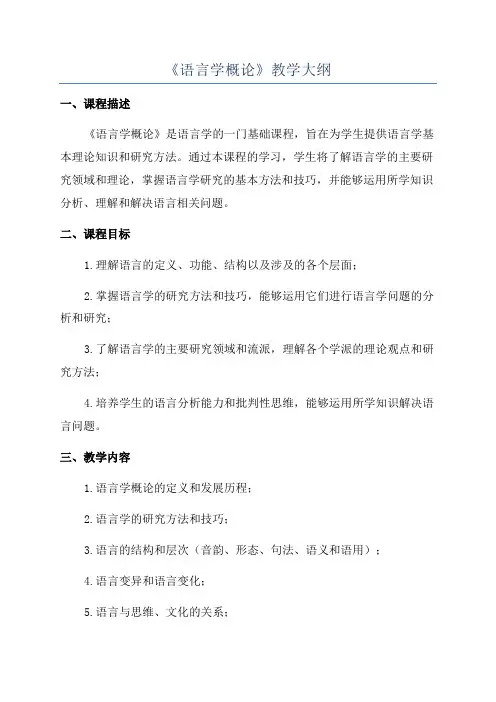
《语言学概论》教学大纲
一、课程描述
《语言学概论》是语言学的一门基础课程,旨在为学生提供语言学基本理论知识和研究方法。
通过本课程的学习,学生将了解语言学的主要研究领域和理论,掌握语言学研究的基本方法和技巧,并能够运用所学知识分析、理解和解决语言相关问题。
二、课程目标
1.理解语言的定义、功能、结构以及涉及的各个层面;
2.掌握语言学的研究方法和技巧,能够运用它们进行语言学问题的分析和研究;
3.了解语言学的主要研究领域和流派,理解各个学派的理论观点和研究方法;
4.培养学生的语言分析能力和批判性思维,能够运用所学知识解决语言问题。
三、教学内容
1.语言学概论的定义和发展历程;
2.语言学的研究方法和技巧;
3.语言的结构和层次(音韵、形态、句法、语义和语用);
4.语言变异和语言变化;
5.语言与思维、文化的关系;
6.语言习得和语言教学;
7.认知语言学、功能语言学、生成语法学等主要流派的概念和研究方法。
四、教学方法
本课程采用多种教学方法,包括讲授、案例分析、学生讨论和小组合作等。
重点培养学生的独立思考和问题解决能力,鼓励学生积极参与课堂讨论和互动。
五、考核方式
1.平时表现:包括课堂表现、作业完成情况和课堂参与等;
2.期中考试:考查学生对于课程知识的掌握情况;
3.课堂讨论:鼓励学生积极参与课堂讨论,对其进行评分;。
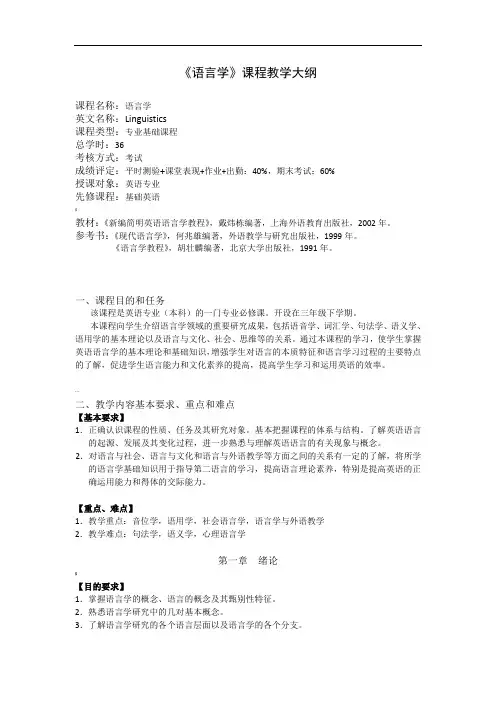
《语言学》课程教学大纲课程名称:语言学英文名称:Linguistics课程类型:专业基础课程总学时:36考核方式:考试成绩评定:平时测验+课堂表现+作业+出勤:40%,期末考试:60%授课对象:英语专业先修课程:基础英语$教材:《新编简明英语语言学教程》,戴炜栋编著,上海外语教育出版社,2002年。
参考书:《现代语言学》,何兆雄编著,外语教学与研究出版社,1999年。
《语言学教程》,胡壮麟编著,北京大学出版社,1991年。
一、课程目的和任务该课程是英语专业(本科)的一门专业必修课。
开设在三年级下学期。
本课程向学生介绍语言学领域的重要研究成果,包括语音学、词汇学、句法学、语义学、语用学的基本理论以及语言与文化、社会、思维等的关系。
通过本课程的学习,使学生掌握英语语言学的基本理论和基础知识,增强学生对语言的本质特征和语言学习过程的主要特点的了解,促进学生语言能力和文化素养的提高,提高学生学习和运用英语的效率。
…二、教学内容基本要求、重点和难点【基本要求】1.正确认识课程的性质、任务及其研究对象。
基本把握课程的体系与结构。
了解英语语言的起源、发展及其变化过程,进一步熟悉与理解英语语言的有关现象与概念。
2.对语言与社会、语言与文化和语言与外语教学等方面之间的关系有一定的了解,将所学的语言学基础知识用于指导第二语言的学习,提高语言理论素养,特别是提高英语的正确运用能力和得体的交际能力。
【重点、难点】1.教学重点:音位学,语用学,社会语言学,语言学与外语教学2.教学难点:句法学,语义学,心理语言学第一章绪论$【目的要求】1.掌握语言学的概念、语言的概念及其甄别性特征。
2.熟悉语言学研究中的几对基本概念。
3.了解语言学研究的各个语言层面以及语言学的各个分支。
【重点、难点】1.教学重点:语言学的概念、语言的概念及其甄别性特征。
2.教学难点:语言学研究中的几对基本概念。
【教学方法与教学手段】%讲授式、讨论式【教学时数】2学时【思考与练习】1﹒How do you interpret the definition of linguistics: Linguistics is the scientific study of language 2﹒What are the major branches of linguistics What does each of them study3﹒What characteristics of language should be included in a good , comprehensive definition of language4﹒What are the main features of human language that have been specified by C. Hockett to show that it is essentially different from animal communication system】第二章音系学【目的要求】1.通过语音学部分的学习,了解各种发音器官及其作用,英语的元音和辅音的发音方式和特点,分清宽式标音法和窄式标音法的区别。

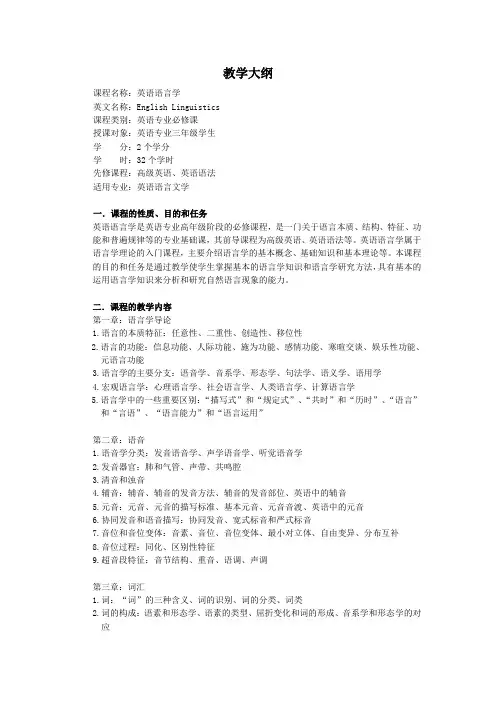
教学大纲课程名称:英语语言学英文名称:English Linguistics课程类别:英语专业必修课授课对象:英语专业三年级学生学分:2个学分学时:32个学时先修课程:高级英语、英语语法适用专业:英语语言文学一.课程的性质、目的和任务英语语言学是英语专业高年级阶段的必修课程,是一门关于语言本质、结构、特征、功能和普遍规律等的专业基础课,其前导课程为高级英语、英语语法等。
英语语言学属于语言学理论的入门课程,主要介绍语言学的基本概念、基础知识和基本理论等。
本课程的目的和任务是通过教学使学生掌握基本的语言学知识和语言学研究方法,具有基本的运用语言学知识来分析和研究自然语言现象的能力。
二.课程的教学内容第一章:语言学导论1.语言的本质特征:任意性、二重性、创造性、移位性2.语言的功能:信息功能、人际功能、施为功能、感情功能、寒暄交谈、娱乐性功能、元语言功能3.语言学的主要分支:语音学、音系学、形态学、句法学、语义学、语用学4.宏观语言学:心理语言学、社会语言学、人类语言学、计算语言学5.语言学中的一些重要区别:“描写式”和“规定式”、“共时”和“历时”、“语言”和“言语”、“语言能力”和“语言运用”第二章:语音1.语音学分类:发音语音学、声学语音学、听觉语音学2.发音器官:肺和气管、声带、共鸣腔3.清音和浊音4.辅音:辅音、辅音的发音方法、辅音的发音部位、英语中的辅音5.元音:元音、元音的描写标准、基本元音、元音音渡、英语中的元音6.协同发音和语音描写:协同发音、宽式标音和严式标音7.音位和音位变体:音素、音位、音位变体、最小对立体、自由变异、分布互补8.音位过程:同化、区别性特征9.超音段特征:音节结构、重音、语调、声调第三章:词汇1.词:“词”的三种含义、词的识别、词的分类、词类2.词的构成:语素和形态学、语素的类型、屈折变化和词的形成、音系学和形态学的对应3.词汇变化:特有的词汇变化、形态变化、语义变化、音位变化、拼写变化第四章:句法:从语词到篇章1.句法关系:组合关系、聚合关系、共现关系2.句法结构和成分:句法结构、成分、直接成分分析法、向心结构和离心结构、并列关系和从属关系3.范畴:范畴、数、性、格、一致关系4.递归性:递归性、连接、嵌入5.句子之外:句子连接、衔接第五章:意义1.“意义”的意义:概念意义、联想意义(内涵意义、社会意义、感情意义、反射意义、搭配意义)、主题意义2.指称论:指称论、概念论、涵义与指称、外延与内涵3.涵义关系:同义关系、反义关系、上下义关系4.语义成分分析法:语义成分分析法第六章:语言与认知1.认知:认知2.心理语言学:语言习得、语言理解、语言的生成3.认知语言学:识解及操作、范畴化、意象图式、隐喻、转喻、整合理论第七章:语言、文化和社会1.语言和文化:情境语境、萨丕尔-沃尔夫假说、个案研究、语言教学中的文化2.语言和社会:语言和社会的联系、社会语境中的文体变异、社会语言学的重要作用、社会语言学的重要启示3.跨文化交际:跨文化交际的重要意义、个案研究第八章:语言的使用1.言语行为理论:施为句和表述句、行事行为理论2.会话含义理论:合作原则、准则的违反、含义的特征第九章:语言与文学1.文学语言的一些普遍特征:前景化和语法形式、字面语言和比喻语言、文学语言的分析2.诗歌语言:语音模式、不同形式的语言模式、重音和韵律模式、传统的韵律模式与语音模式、语音和韵律在诗歌中的功能、如何分析诗歌3.小说中的语言:小说与视角、言语和思维的表达、散文风格、如何分析小说语言4.戏剧语言:如何分析戏剧、分析戏剧语言、如何分析剧本5.从认知角度分析文学:理论背景、认知分析举例三.课程的基本要求1.正确理解语言的本质特征,语言的功能,分清语言学的主要分支以及宏观语言学的基本涵盖范围,掌握语言学中的一些重要区别。
《语言学概论》教案一、教学目标1.知识与技能:(1)了解语言学的定义、研究对象和研究方法;(2)掌握语言学的基本分支,如语音学、语法学、语义学、语用学等;(3)理解语言的本质特征,如符号性、结构性、层次性等;(4)掌握语言与思维、文化、社会等方面的关系。
2.过程与方法:(1)通过案例分析,培养学生运用语言学知识分析语言现象的能力;(2)通过小组讨论,培养学生合作学习、共同探究的能力;(3)通过课堂讲解、课后阅读,提高学生的语言表达能力。
3.情感态度与价值观:(1)培养学生对语言学的兴趣和热爱;(2)增强学生的跨文化交际意识;(3)培养学生尊重语言多样性、维护民族团结的观念。
二、教学内容1.语言学的定义、研究对象和研究方法;2.语言学的基本分支,如语音学、语法学、语义学、语用学等;3.语言的本质特征,如符号性、结构性、层次性等;4.语言与思维、文化、社会等方面的关系;5.语言学在实际生活中的应用。
三、教学安排1.第一周:导论(语言学的定义、研究对象和研究方法)2.第二周:语音学(语音、音素、音位等)3.第三周:语法学(词法、句法等)4.第四周:语义学(词义、句义等)5.第五周:语用学(语境、言外之意等)6.第六周:语言与思维、文化、社会等方面的关系7.第七周:语言学在实际生活中的应用(案例分析、小组讨论等)8.第八周:复习与考试四、教学方法1.讲授法:教师对语言学的基本概念、理论进行讲解,帮助学生建立完整的知识体系;2.案例分析法:通过分析具体语言现象,引导学生运用所学知识;3.小组讨论法:分组讨论,培养学生合作学习、共同探究的能力;4.课后阅读法:布置相关阅读材料,提高学生的自主学习能力。
五、教学评价1.过程评价:课堂参与度、小组讨论表现、课后作业完成情况等;2.终结性评价:期末考试成绩;3.自我评价:学生对自己在学习过程中的收获和不足进行反思。
六、教学资源1.教材:《语言学概论》(具体版本根据实际情况选择);2.辅助资料:相关学术论文、案例集、网络资源等;3.教学工具:多媒体设备、黑板、粉笔等。
英语简明语言学课程设计一、课程目标知识目标:1. 学生能够理解并掌握语言学基本概念,如音素、音节、词汇、句子结构等;2. 学生能够描述英语语音、语法、词汇等方面的特点;3. 学生能够了解英语语言的发展历史及其与文化的关联。
技能目标:1. 学生能够运用语言学知识分析日常英语语言现象,提高语言感知能力;2. 学生能够通过实例分析,提高英语语法和词汇运用的准确性;3. 学生能够运用所学知识进行简单的语言学研究,提高思辨能力。
情感态度价值观目标:1. 学生培养对英语语言学研究的兴趣,增强学习英语的动力;2. 学生树立正确的语言观念,尊重并欣赏不同语言的多样性;3. 学生通过语言学课程的学习,增强对中华文化的自豪感,培养跨文化交际意识。
课程性质:本课程旨在帮助学生从语言学角度深入了解英语,提高学生的语言素养和跨文化交际能力。
学生特点:高中年级的学生已经具备一定的英语基础,对语言学有一定的好奇心,但可能缺乏系统的语言学知识和研究方法。
教学要求:结合学生特点,课程设计应注重理论与实践相结合,以实例分析为主,激发学生兴趣,提高学生的实际运用能力。
同时,注重培养学生的思辨能力和跨文化交际意识。
通过具体的学习成果评估,确保课程目标的实现。
二、教学内容1. 语言学基本概念:音素、音节、词汇、句子结构等;教材章节:第一章 语言与语言学2. 英语语音特点:音标、发音规则、连读、语调等;教材章节:第二章 英语语音3. 英语语法结构:词类、句型、时态、语态等;教材章节:第三章 英语语法4. 英语词汇特点:词义、词性、词汇搭配、词源等;教材章节:第四章 英语词汇5. 语言与文化:英语国家文化背景、交际礼仪、跨文化交际等;教材章节:第五章 语言与文化6. 语言学研究方法:观察、实证研究、案例分析等;教材章节:第六章 语言学与语言研究教学内容安排与进度:第一周:语言学基本概念第二周:英语语音特点第三周:英语语法结构第四周:英语词汇特点第五周:语言与文化第六周:语言学研究方法三、教学方法本课程将采用以下多样化的教学方法,以激发学生的学习兴趣和主动性:1. 讲授法:针对语言学基本概念、语法结构等理论性较强的内容,通过教师系统、清晰的讲解,帮助学生建立扎实的理论基础。
来源:《英语语言学概论》课程组发布时间:2007-5-6 21:42:00 已经阅读293次Lecture oneChapter 1 IntroductionI. Objectives: Ss are to know the following from this lecture1. What linguistics is2. The scope of linguistics3. Some important distinctions in linguisticsII. ProceduresA. Get to know each other(5’)B. Introduce the book as well as the authors(10’)C. Requirements and evaluation of the course(5’)D. New Contents:1. What linguistics is (20’)2. The scope of linguistics (25’)(1) The core of linguistics:a. Phoneticsb. Phonologyc. Morphologyd. Syntaxe. Semanticsf. Pragmatics(2) Interdisciplinary branches of linguistic studya. Scociolinguisticsb. Psycholinguisticsc. Applied Linguistics3. Some important distinctions in linguistics (23’)(1) prescriptive vs. descriptive(2) synchronic vs. diachronic(3) speech vs. writingE. Home work(2’)(1) Qs 1-5 (Pp.7-9) (oral)(2) Gather information about Saussure and Chomsky(3) Prepare the rest of 1.1.3Lecture 2Chapter 1 IntroductionI. Objectives: Ss are to know the following from this lecture1. other important distinctions in linguistics2. The definition of language3. Some functions of languageII. ProceduresA. Review questions (15’):1. How do you understand that “linguistics is the scientific study of language”?2. What's the difference between phonetics and phonology?3. What's the difference between semantics and pragmatics?4. Why is speech considered as the primary medium of human language?B. New Contents:1. other important distinctions in linguistics (25’):(4) Langue Vs. Parole(5) Competence Vs. performance(6) Traditional grammar Vs. modern linguistics2. The definition of language (15'):a. The definitionb. How to understand the definition3. Some of the functions of language (33'):a. Informativeb. Interrogativec. Interpersonald. Performativee. Directivef. Emotiveg. Expressiveh. Phatici. Recreationalj. MetalingualC. Home work(2’)1. Pp. 12 6 (written)2. Prepare the rest of the chapter.Lecture 3Chapter 1 IntroductionI. Objectives: Ss are to know the following from this lecture1. Some design features of language2. Some theories as to the origin of languageII. ProceduresA. Review questions (15’):1. What’s the difference between langue and parole?2. What’s the difference between competence and performance?3. What’s the difference between the distinction of langue Vs. parole and that of competence Vs. performance?4. Please name and explain with examples some functions of language.B. New Contents:1. Five design features of language (25’):a. Arbitrarinessb. Productivityc. Displacementd. Dualitye. Cultural transmission2. Some theories as to the origin of language (15):a. The Divine- Origin Theoryb. The Invention Theory:1. The Bow-wow theory2. The Pooh-pooh theory3. The “Yo-he-ho” theory4.The Ding-dong theoryc. the evolutionary theory1. Children are born with both thought and language.2. The development of the physical apparatus for speech.3. It is labor that created the necessity for language.C. Home work(2’)1. P.12, Q8 (oral)2. Prepare 2.1&2.2.Lecture 4Chapter 2 PhonologyI. Objectives: Ss are to know the following from this lecture1. The phonic medium of language2. The branches of phonetics3. Organs of speech4. Orthographic representation of speech sounds5. Classification of English speech soundsII. ProceduresA. Review questions (10’):Give examples to show the following features that make human language different from animal communication system:1. Arbitrariness2. Productivity3. Duality4. Displacement5. Cultural transmissionB. New Contents:1. The concept of phonic medium of language and speech sounds (10’)a. The phonic medium of languageb. Speech sounds2. Three branches of phonetics (10’):a. articulatory phoneticsb. acoustic phoneticsc. auditory phonetics3. Organs of speech (15’)a. the pharyngeal cavityb. the oral cavityc. the nasal cavity4. Classification of English speech sounds (43)a. consonants Vs. vowelsb. Consonantsc. vowelsC. Home work(2’)1. P. 31: 2-5 (oral)2. P.31: 6 (written)3. Prepare 2.3: PhonologyLecture 5Chapter 22.3 PhonologyI. Objectives: Ss are to know the following from this lecture1. The differences between phonology and phonetics2. The concepts of phone, phoneme, allophone, phonemic contrast, complementary distribution, and minimal pair3. Some rules in phonology4. Some suprasegmental featuresII. ProceduresA. Review questions (10’):1. In what ways can English consonants be classified?2. In what ways can English vowels be classified?B. New Contents:1. Phonology and Phonetics(10’)a. Phonologyb. Differences between Phonology and Phonetics2. Phone, Phoneme, and Allophone (15’):a. Phoneb. Phonemec. Allophone3. Phonemic contrast, complementary distribution, and minimal pair (20’)a. Phonemic contrastb. complementary distributionc. minimal paird. Minimal set4. Some rules in phonology (15’)a. Sequential rulesb. Assimilation rulec. Deletion rule5. Suprasegmental features (18’)a. Stressb. Tonec. IntonationC. Home work(2’)1. Review2. P.31: 7-10 (oral)3. Prepare Chapter 3Lecture 6Chapter 3 MorphologyI. ObjectivesSs are to know the following through this lecture:1. Types of Morphemesa. Prefix/suffixb. Free/boundc. Derivational morpheme/inflectional morpheme2. English word formationa. derivationb. compoundII. ProceduresA. Review question s(10’)1. How are English consonants classified?2. How are English V owels classified?B. New Contents (77’)1. definition2. types of Morphemesa. Prefix/suffixb. Free/boundc. Derivational morpheme/inflectional morpheme3. English word formationa. derivationb. compounda) grammatical categoryb). stressc). meaning4. contrast between English and Chinese word formationC. Summary (1’)III. Home work (2’)1. Review2. Pp. 40 Ex.1-4 (oral)3. Prepare Chapter 5Lecture 7Chapter 5 Semantics (5.1-2)I. Objectives: Ss are to know the following from this lecture1. The scope of phonetics2. A brief history of semantics3. 4 views concerning the study of meaning4. Classification of meaningII. ProceduresA. Review questions (10’):Q1. What’s the difference between phonetics and phonology?Q2. Define the following terms:a. phonemeb. allophonec. minimal pairB. New Contents:1. The scope of semantics (10’)a. Definitionb. Scope2. A brief history of semantics (10’): preparatorya. etymologicalb. structuralistc. pluralist3. 4 views concerning the study of meaning (43’)a. the naming theoryb. the conceptualist viewc. contextualismd. behaviorism4. Classification of meaning (15)a. Grice'sb. Kitty'sc. Leech'sC. Home work(2’)1. Review2. Q1, Pp82. (oral)3. Prepare 5.3: Lexical meaningLecture 8Chapter 5 Semantics (5.3)I. Objectives: Ss are to know the following from this lecture1. The distinction between sense and reference2. Major sense relations on the lexical levela. synonymyb. polysemyc. homonymyd. hyponymye. antonymyII. ProceduresA. Review question (10’):What are the major views concerning the study of meaning?B. New Contents:1. Sense and reference (20’)a. senseb. referencec. sense Vs. reference2. Major sense relations on the lexical level (58’):a. Synonymyi. dialectalii. stylisticiii. differing in their emotive or evaluative meaningiv. collocationalv. semantically differentb. polysemyc. homonymyd. hyponymye. antonymyi. gradable antonymsii. complementary antonymsiii. relational oppositesC. Home work(2’)1. Review2. Qs 2-4, Pp82. (oral)3. Prepare 5.4: Sense relations between sentencesLecture 9Chapter 5 Semantics (5.4/5.5)I. Objectives: Ss are to know the following from this lecture1. Major sense relations between sentences:a. X is synonymous with Yb. X is inconsistent with Yc. X entails Yd. X presupposes Ye. X is a contradictionf. X is semantically anomalous2. Major presupposition triggersII. ProceduresA. Review questions (10’):1. What’s the difference between sense and reference?2.What are the major sense relations on the lexical level? Explain.B. New Contents:1. Major sense relations on the syntactic level (35’):a. X is synonymous with Yb. X is inconsistent with Yc. X entails Yd. X presupposes YA brief introduction of presupposition triggers1) definite descriptions2) factive verbs3) implicative verbs4) change of state verbs5) iteratives6) verbs of judging7) adverbial clauses of time8) cleft sentences9) structures and expressions indicating comparison10) counterfactual conditionals11) non-restrictive attributive clauses12) questionse. X is a contradictionf. X is semantically anomalous2. Componential analysis (23’):1. Definition2. Examples3. Classification of semantic features4. Abstraction of semantic features5. Strong Points6. Weak Points3. Predication analysis (20’)1. Sentence Meaning2. Grammatical meaning3. Selection Restriction4. Predication Analysis5. Examples6. More Examples7. CA+PN8. Strong points of formalization of meaning9. Weak points of formalization of meaningC. Home work (2’)1. Review2. P82: 2-5 (written)3. Prepare 6: PragmaticsLecture 10Chapter 6 Pragmatics6.1 Some Basic NotionsI. Objectives: Ss are to know the following from this lecture1. definition of pragmatics2. difference between pragmatics and semantics3. context4. difference between sentence meaning and utterance meaning II. ProceduresA. Review question (10’):1. Define the following 2 terms:(1) Componential analysis(2) Predication analysis2. What does a predication consist of?B. New Contents:1. Definition (25’):1. different definitons2. common place3. topics in pragmatics4. origin and development of pragmatics2. pragmatics vs. semantics (15’)1. research methods2. scope3. key in the distinction3. Context (15’)1. definiton2. cognitive context3. importance of context4. examples4. Sentence meaning vs. utterance meaning (23’)1. Sentence vs. utterance2. sentence meaning vs. utterance meaning3. examples4. more examplesC. Home work (2’)1. Review2. Pp. 94: Ex. 1-3 (oral)3. Prepare 6.2Lecture 11Chapter 6 Pragmatics6.2 Speech Act TheoryI. Objectives: Ss are to know the following from this lecture1. Austin’s model of speech acts2. Searle’s classification of speech acts3. Speech act theory and indirectness of speechII. ProceduresA. Review question (15’):• 1. What’s the difference between pragmatics and semantics?• 2. What’s the difference between sentence meaning and utterance meaning?• 3. Try to think of contexts in which the following sentence can be used for other purposes than just stating a fact:•“The final examination is drawing near.”B. New Contents:1. Austin’s model of speech acts(35’)1. Origin of the theory2. Examples of performatives3. Main idea4. Felicity/Happiness conditions5. Grammatical and lexical criteria6. Counter examples7. More counter examples8. Cancellation of the distinction9. Development of the theory10.“Three act” model11. Example12. Austin’s classification of I A13. Austin’s Place2. Searle’s classification of speech acts (25’)1. Criteria for the classification2. 5/6 types of IA3. Speech act theory and indirect speech (13’)1. Indirectness of speech2. Examples3. Speech act theory and indirect speechC. Home work (2’)• 1. Review• 2. Pp. 94: Ex. 4-6 (oral)• 3. Prepare 6.3Lecture 12Chapter 6 Pragmatics6.3 Principle of ConversationI. ObjectivesSs are to know the following through this lecture:2. The flouting of the maxims and conversational implicature3. The flouting of the maxims and rhetoric4. Development of CPII. ProceduresA. Review questions (10’)1. According to Austin, what are the three acts a person is possibly performing while making an utterance. Explain with the following example:“Oh! What nice apples!”2. Explain with examples the five types of illocutionary act classified by Searle:(1) representatives(2) directives(3) commissives(4) expressives(5) declarationsB. New Contents:1. CP Proper (25’)1. Origin of the theory2. Main idea3. CP explained4. The maxims2. The flouting of the maxims and conversational implicature (35’)1. Main idea2. Examples3. Exercises4. More exercises5. Features of conversational implicature3. Flouting of the maxims and rhetoric (10’)1. Main idea2. Examples3. More Example4. Post-Gricean Developments (8’)2.Post-Gricean developmentsC. Summary (1’)III. Home work (1’)1. Review2. Pp. 94: Ex. 7 (written)3. Prepare Chapter 7Lecture 13Chapter 7 Language ChangeI. ObjectivesSs are to know the following through this lecture:1. Changes at different levels of languagea. soundb. grammarc. vocabulary2. Recent change in normal English usage3. Causes of language changeII. ProceduresA. Review question (10’)What are the four maxims of the CP? Try to give your own examples to show how flouting of these maims gives rise to conversational implicature.B. New Contents (77’)1. Sound change2. morphological and syntactic changea. change in “agreement” ruleb. change in negation rulec. process of simplificationd. loss of inflections3. V ocabulary changea. addition of new wordsb. loss of wordsc. changes in the meaning of words4. Some recent trends1). Moving towards greater informality2). The influence of American English3). The influence of science and technologya. space travelb. computer and internet languagec. ecology5. Causes of language change1). The rapid development of science and technology2). Social and political changes and political needs3). The way children acquire the language4). Economy of memory5). The desire to be intelligibleC. Summary (1’)III. Home work (2’)1. Review2. Pp. 109: 1-8 (oral)3. Prepare Chapter 8 (1-2)Lecture 14Chapter 8 Language and Society (8.1-8.2)I. ObjectivesSs are to know the following through this lecture:1. The scope of sociolinguisticsa. The relatedness between language and societyb. Speech community and speech varietyc. Two approaches to sociolinguistic studies2. Varieties of languagea. dialectal varietiesb. registerc. degree of formalityII. ProceduresA. Review question (20’)1. Define the following 4 terms:1) bound morpheme2) free morpheme3) derivational morpheme4) inflectional morpheme2. List as many as possible methods for the addition of new words.3. What are the 3 processes for semantic change of words?B. New Contents (67’)1. The scope of sociolinguisticsa. The relatedness between language and societyb. Speech community and speech varietyc. Two approaches to sociolinguistic studies2. Varieties of languagea. dialectal varieties1). regional dialect2). sociolect3). language and gender4). language and age5). idiolect6). ethnic dialectb. registerc. degree of formalityC. Summary (1’)III. Home work (2’)1. Review2. Pp. 126 Ex.1-6 (oral)3. Prepare Chapter 8 (3-5)Lecture 15Chapter 8 Language and Society (8.3-8.5)I. ObjectivesSs are to know the following through this lecture:1. standard dialect2. pidgin and Creole3. bilingualism and diglossiaII. ProceduresA. Review question (15’)1. What are the ways that language is related with society?2. List as many dialectal varieties as possible.3. What are the three social variables that determine the register? What is each concerned with?B. New Contents (72’)1. standard dialecta. definitionb. features2. pidgin and Creolea. pidgin1). definition2). featuresb. Creole1). definition2). features3. bilingualism and diglossiaa. bilingualismb. diglossiaC. Summary (1’)III. Home work (2’)1. Review2. Pp. 126 Ex. 7-8 (oral)3. Prepare Chapter 9 (1-4)Lecture 16Chapter 9 Language and Culture (9.1-4)I. ObjectivesSs are to know the following through this lecture:1. the scope of the study2. what culture is3. the relationship between language and culture4. Sapir-Whorf hypothesisII. ProceduresA. Review question (15’)Define the following 4 terms:1. Pidgin2. Creole3. Bilingualism4. diglossiaB. New Contents (72’)1. the scope of the studya. language and cultureb. language and thought2. what culture isa. definitionb. culture Vs. nature3. the relationship between language and culturea. exampleb. specific relationshipsc. summary4. Sapir-Whorf hypothesisa. definitionb. weak versionc. strong versionC. Summary (1’)III. Home work (2’)1. Review2. Pp. 141 Ex. 1-2 (oral)3. Prepare Chapter 9 (5-8)Lecture 17Chapter 9 Language and Culture (9.5-9.8)I. ObjectivesSs are to know the following through this lecture:1. linguistic evident of cultural differences2. significance of cultural teaching and learning3. cultural overlap and diffusion4. intercultural communicationII. ProceduresA. Review question (15’)Define the term:Sapir-Whorf hypothesisB. New Contents (72’)1. linguistic evident of cultural differencesa. greetings and terms of addressb. thanks and complimentsd. privacy and taboose. rounding off numbersf. words and cultural-specific connotationsg. cultural-related idioms, proverbs and metaphors2. significance of cultural teaching and learning3. cultural overlap and diffusiona. cultural imperialismb. linguistic imperialismc. linguistic nationalism4. intercultural communicationC. Summary (1’)III. Home work (2’)1. Review2. Pp. 141: 3-6 (oral)3. Get prepared for the exam。